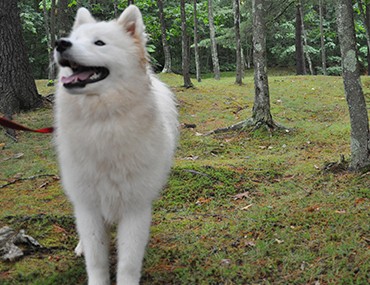Background:
The Samoyed dog springs from the Samoyed tribe, who were forced from Southern Asia centuries ago and into northern Siberia. Recent DNA testing has shown the Samoyed, along with thirteen other breeds, to be among the most ancient of dogs. The Samoyed is probably the best indication of what wild dogs used to look like, they have no wolf or fox lineage.
Samoyeds were used to herd reindeer and protect them from predators. They were also important for hunting and pulling sleds, which was the only way to get around northern Siberia. Samoyeds were a vital part of the Samoyed tribe’s lifestyle and even responsible for keeping the tribe warm at night. The Samoyed people relied on these dogs for almost every aspect of daily life.
Samoyeds went to England in the 1800s and weren’t necessarily white, as we know them to be today. One was gifted to Queen Alexandria and she immediately became an advocate for the breed. The first Samoyeds in America came in 1906 and were recognized by the American Kennel Club that same year, after being popularized as a sled dog in Antarctica.
Sizing up:
- Weight: 50 to 60 lbs.
- Height: 19 to 23.5 inches
- Coat: Dense, double layer
- Color: White, white and biscuit
- Life expectancy: 12 to 14 years
What’s the Samoyed like?
Samoyeds are always ready for adventure and you can see it from the smile on their faces. Samoyeds are true to their heritage: herding, running, and pulling whatever and whenever they can. These traits would be well suited to a person who exercises daily. Samoyeds can easily keep up with you under cold weather conditions and are particularly partial to sledding and skiing.
Samoyeds are also great around kids because of their kind and gentle personality but they might try and herd them. The Samoyed’s sweet demeanor makes him a poor watchdog, although barking a friendly hello to strangers is almost a certainty.
Samoyeds bark loudly and can be incessant so it’s important that you keep them entertained with games and plenty of exercise. Samoyeds are never lazy and if not properly worked they can easily turn to destructive behavior. Samoyeds thick coat is no excuse to leave them outside all the time. They need to be with the family just as their ancestors did.
Samoyeds love to chase anything. The best way to keep them safe is to keep them behind a fence or on a leash. They’re fast and can jump, so make sure you consider that when you’re trying to keep them in the backyard.
Grooming will be a frequent responsibility.
Health:
Possible conditions that might affect Samoyeds include the following:
- Hip dysplasia
- Pulmonary stenosis
- Progressive retinal atrophy
- Diabetes mellitus
Takeaway Points:
- Samoyeds were both sled dogs and hunters. They’ll need strenuous daily exercise.
- Samoyed coats are thick and require regular grooming.
- Samoyeds play well with children and are always excited to meet new people.
- Samoyeds will chase just about anything so it’s important that you keep them safe.
If you have any questions or concerns, you should always visit or call your veterinarian – they are your best resource to ensure the health and well-being of your pets.
